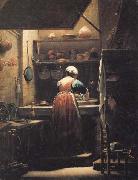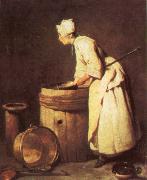Wholesale Oil Painting No Minimum |
|||||||||||
|
|
|||||||||||

|
|||||||||||
|
|
|
||||||||
CRESPI, Giuseppe MariaItalian Baroque Era Painter, 1665-1747 Painter, draughtsman and printmaker. His religious and mythological works are distinguished by a free brushstroke and a painterly manner. He also painted spirited genre scenes, which by their quality, content and quantity distinguish him as one of the first Italian painters of high standing to devote serious attention to the depiction of contemporary life. Such paintings as Woman Laundering (1700-05; St Petersburg, Hermitage) or Woman Washing Dishes (1720-25; Florence, Uffizi) offer straightforward glimpses of domestic chores in images that are startlingly novel for the period and look forward to the art of Jean-Simeon Chardin, Jean-Francois Millet and Honore Daumier. |
||||||||
|
|
||||||||
The Scullery Maid
The Scullery Maid Painting ID:: 28828 |
mk65
Oil on canvas
22 7/16x16 15/16in
mk65 Oil on canvas 22 7/16x16 15/16in |
|||||||
|
|
||||||||
Jean Baptiste Simeon Chardin1699-1779 French Jean Baptiste Simeon Chardin Locations Chardin was born in Paris, the son of a cabinetmaker, and rarely left the city. He lived on the Left Bank near Saint-Sulpice until 1757, when Louis XV granted him a studio and living quarters in the Louvre. Chardin entered into a marriage contract with Marguerite Saintard in 1723, whom he did not marry until 1731. He served apprenticeships with the history painters Pierre-Jacques Cazes and Noël-Nicholas Coypel, and in 1724 became a master in the Acad??mie de Saint-Luc. Upon presentation of The Ray in 1728, he was admitted to the Acad??mie Royale de Peinture et de Sculpture. The following year he ceded his position in the Acad??mie de Saint-Luc. In November of 1731 his son Jean-Pierre was baptized, and a daughter, Marguerite-Agn??s, was baptized in 1733. In 1735 his wife Marguerite died, and within two years Marguerite-Agn??s had died as well. The Ray, 1728, Mus??e du Louvre, Paris.Beginning in 1737 Chardin exhibited regularly at the Salon. He would prove to be a dedicated academician, regularly attending meetings for fifty years, and functioning successively as counsellor, treasurer, and secretary, overseeing in 1761 the installation of Salon exhibitions. In 1744 he entered his second marriage, this time to Françoise-Marguerite Pouget. The following year a daughter, Ang??lique-Françoise, was born, but she died in 1746. In 1752 Chardin was granted a pension of 500 livres by Louis XV. At the Salon of 1759 he exhibited nine paintings; it was the first Salon to be commented upon by Denis Diderot, who would prove to be a great admirer and public champion of Chardin work. Beginning in 1761, his responsibilities on behalf of the Salon, simultaneously arranging the exhibitions and acting as treasurer, resulted in a diminution of productivity in painting, and the showing of replicas of previous works. In 1763 his services to the Acad??mie were acknowledged with an extra 200 livres in pension. In 1765 he was unanimously elected associate member of the Acad??mie des Sciences, Belles-Lettres et Arts of Rouen, but there is no evidence that he left Paris to accept the honor.[8] By 1770 Chardin was the Premiere peintre du roi, and his pension of 1,400 livres was the highest in the Academy. In 1772 Chardin son, also a painter, drowned in Venice, a probable suicide. The artist last known oil painting was dated 1776; his final Salon participation was in 1779, and featured several pastel studies. Gravely ill by November of that year, he died in Paris on December 6, at the age of 80. |
||||||||
|
|
||||||||
|
|
The Scullery Maid
The Scullery Maid Painting ID:: 52727 |
mk223
Oil on canvas
mk223 Oil on canvas |
||||||
|
|
||||||||
|
Jean Baptiste Simeon Chardin 1699-1779 French Jean Baptiste Simeon Chardin Locations Chardin was born in Paris, the son of a cabinetmaker, and rarely left the city. He lived on the Left Bank near Saint-Sulpice until 1757, when Louis XV granted him a studio and living quarters in the Louvre. Chardin entered into a marriage contract with Marguerite Saintard in 1723, whom he did not marry until 1731. He served apprenticeships with the history painters Pierre-Jacques Cazes and Noël-Nicholas Coypel, and in 1724 became a master in the Acad??mie de Saint-Luc. Upon presentation of The Ray in 1728, he was admitted to the Acad??mie Royale de Peinture et de Sculpture. The following year he ceded his position in the Acad??mie de Saint-Luc. In November of 1731 his son Jean-Pierre was baptized, and a daughter, Marguerite-Agn??s, was baptized in 1733. In 1735 his wife Marguerite died, and within two years Marguerite-Agn??s had died as well. The Ray, 1728, Mus??e du Louvre, Paris.Beginning in 1737 Chardin exhibited regularly at the Salon. He would prove to be a dedicated academician, regularly attending meetings for fifty years, and functioning successively as counsellor, treasurer, and secretary, overseeing in 1761 the installation of Salon exhibitions. In 1744 he entered his second marriage, this time to Françoise-Marguerite Pouget. The following year a daughter, Ang??lique-Françoise, was born, but she died in 1746. In 1752 Chardin was granted a pension of 500 livres by Louis XV. At the Salon of 1759 he exhibited nine paintings; it was the first Salon to be commented upon by Denis Diderot, who would prove to be a great admirer and public champion of Chardin work. Beginning in 1761, his responsibilities on behalf of the Salon, simultaneously arranging the exhibitions and acting as treasurer, resulted in a diminution of productivity in painting, and the showing of replicas of previous works. In 1763 his services to the Acad??mie were acknowledged with an extra 200 livres in pension. In 1765 he was unanimously elected associate member of the Acad??mie des Sciences, Belles-Lettres et Arts of Rouen, but there is no evidence that he left Paris to accept the honor.[8] By 1770 Chardin was the Premiere peintre du roi, and his pension of 1,400 livres was the highest in the Academy. In 1772 Chardin son, also a painter, drowned in Venice, a probable suicide. The artist last known oil painting was dated 1776; his final Salon participation was in 1779, and featured several pastel studies. Gravely ill by November of that year, he died in Paris on December 6, at the age of 80. The Scullery Maid mk223 Oil on canvas |
||||||||
|
|
||||||||
|
Prev Next
|
||||||||
|
|
||||||||
|
Related Paintings to Jean Baptiste Simeon Chardin :. |
||||||||
|
|
||||||||
|
CONTACT US |


